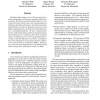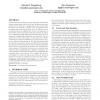19 search results - page 2 / 4 » Temporary Data in Shared Dataspace Coordination Languages |
HIPS
1998
IEEE
13 years 11 months ago
1998
IEEE
Distributed shared objects are a well known approach to achieve independenceof the memory model for parallel programming. The illusion of shared (global) objects is a conabstracti...
COORDINATION
2004
Springer
14 years 26 days ago
2004
Springer
There has been significant recent interest in exploring the role of coordination languages as middleware for distributed systems. These languages provide operations that allow pro...
HLPPP
1991
13 years 11 months ago
1991
Swarm is a computational model which extends the UNITY model in three important ways: (1) UNITY’s fixed set of variables is replaced by an unbounded set of tuples which are add...
TLDI
2005
ACM
14 years 1 months ago
2005
ACM
Coordinated data structures are sets of (perhaps unbounded) data structures where the nodes of each structure may share types with the corresponding nodes of the other structures....
POPL
2009
ACM
14 years 2 months ago
2009
ACM
With the emergence of commodity multicore architectures, exploiting tightly-coupled parallelism has become increasingly important. Functional programming languages, such as Haskel...


